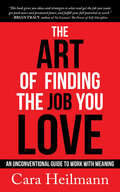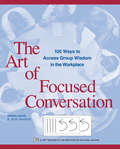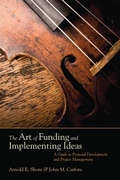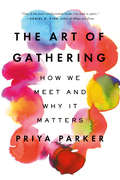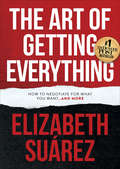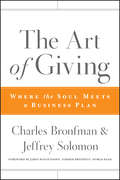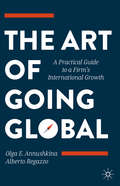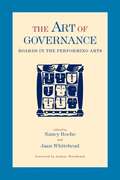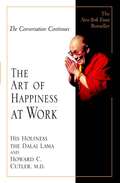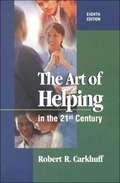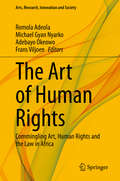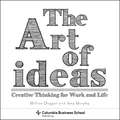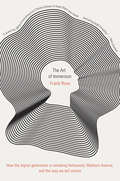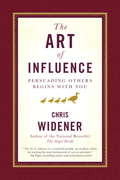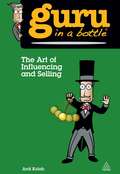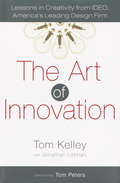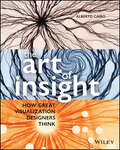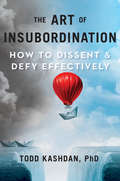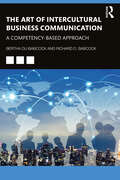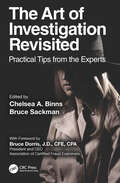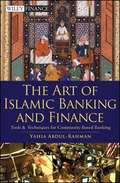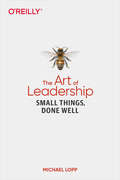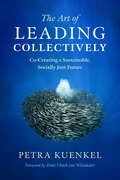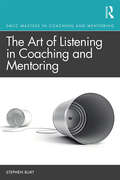- Table View
- List View
The Art of Finding the Job You Love: An Unconventional Guide to Work with Meaning
by Cara HeilmannHe wants to do something new, maybe a little bit righteous. She sees herself leading a nonprofit or creating a medical device that saves lives in the remotest parts of the world. However, the search process has changed radically from the last time they looked for a job.Like many job seekers, they&’ve done a lot and can do a lot. But, recruiters can&’t see past old job titles to recognize how a candidate can contribute to the work force in new ways. And worse, the candidate feels tongue-tied for the first time in their career. In The Art of Finding the Job You Love, Cara Heilmann, CEO of Ready Reset Go®, offers a fresh, safe, and unconventional way to help job seekers speak their talents and passion to make a difference through their work. She connects the worlds of comedy and recruiting with a look behind the curtain to share what hiring managers are really looking for and reveals why the more successful people are, the more they wing interview prep—and how that can work against them. Readers learn how to:Get clear on the targeted job to make everything easierCreate (at least) five riveting career stories that must be in every job seeker&’s toolboxUnderstand how to connect with chemistry during the interview process—even for the most introverted introvertMake a lasting positive impression that sticks well after the interview The Art of Finding the Job You Love helps job seekers craft compelling career stories and communicate them in a way that leaves hiring managers wanting more and job seekers with the opportunity to make a difference in the world through a career they love!
The Art of Focused Conversation
by R. Brian StanfieldThis book has served me so well in my new job. I can't tell you how many times I have pulled the book off the shelf to get some direction in creating my own questions. It has been a great asset in helping me have meaningful and directed conversations at a critical time in my new job. And it has saved me precious time. - Great book!?Marlene Lockwood, Group Leader, St. Helen's Hospital, Deer Park, CaliforniaCommunication within many organizations has been reduced to email, electronic file transfer, and hasty sound bytes at hurried meetings. More and more, people appear to have forgotten the value of wisdom gained by ordinary conversations.But, at different times in history, conversation has been regarded as an art form - a crucial component of human relations. Conversation has the power to solve a problem, heal a wound, generate commitment, bond a team, generate new options, or build a vision. Conversations can shift working patterns, build friendships, create focus and energy, cement resolve.The Art of Focused Conversation convincingly restores this most human of attributes to prime place within businesses and organizations, and demonstrates what can be accomplished through the medium of focused conversation. The first Part describes the theory and background of the conversation method, which has been effectively used for group consensus making in: 1) problem solving; 2) troubleshooting; 3) coaching; 4) research and 5) interpretation of data. It also discusses how to prepare a conversation, how to lead a conversation, and what the common mistakes are. Part two then provides 100 sample conversations designed for use in many different situations, including: 1) reviewing and evaluating; 2) preparation and planning; 3) coaching, and mentoring; 4) data and media interpretation; 5) decision making; 6) managing and supervising; and 7) personal reflection and group celebrations.Developed, tested, and extensively used by professionals in the field of organizational development, The Art of Focused Conversation is an invaluable resource for all those working to improve communications in firms and organizations."This book is absolutely fabulous. I started it last night, used a whole bunch of stuff
The Art of Funding and Implementing Ideas: A Guide to Proposal Development and Project Management
by Arnold R. Shore John M. CarforaTakes the reader to a new level in proposal writing "The authors have captured the gestalt of grant writing in a lucid fashion. In short, I think students would appreciate the clarity and insights this book offers."—Robert J. Hard, University of Texas at San Antonio "As a research scientist who is frequently involved in proposal development myself, it is clear to me that the authors have travelled the grant writer's path before." —John V. Stone, Michigan State University This resource provides a step-by-step approach to turning a research idea into a proposal worthy of funding, demystifying the process as a result. The authors present a proven approach to the development of research ideas alongside a systematic treatment of proposals section-by-section and project management function-by-function. Highly accessible, this book gives examples for each aspect of the proposal development and works through sketches of ideas to fully developed proposal sections. Key FeaturesContains idea development linked to specific proposal sections: Supports creativity that can be captured effectively and systematically one step at a time. Uses sketches to facilitate idea development and make enhancement and revisions easy: Allows for ease in trying out alternative formulations and revising preliminary approaches. Provides international research proposals: Key to understanding resources for proposing international research collaborations.Shows how to manage a funded project: Guides researchers and research staff in effectively implementing a funded project.This book is appropriate for all graduate students across the health, social, and behavioral sciences who need guidance on writing successful, compelling funding proposals.
The Art of Gathering: How We Meet and Why It Matters
by Priya Parker"Hosts of all kinds, this is a must-read!" --Chris Anderson, owner and curator of TEDA bold new approach to how we gather that will transform the ways we spend our time together--at work, at home, in our communities, and beyond.In The Art of Gathering, Priya Parker argues that the gatherings in our lives are lackluster and unproductive--which they don't have to be. We rely too much on routine and the conventions of gatherings when we should focus on distinctiveness and the people involved. At a time when coming together is more important than ever, Parker sets forth a human-centered approach to gathering that will help everyone create meaningful, memorable experiences, large and small, for work and for play.Drawing on her expertise as a facilitator of high-powered gatherings around the world, Parker takes us inside events of all kinds to show what works, what doesn't, and why. She investigates a wide array of gatherings--conferences, meetings, a courtroom, a flash-mob party, an Arab-Israeli summer camp--and explains how simple, specific changes can invigorate any group experience.The result is a book that's both journey and guide, full of exciting ideas with real-world applications. The Art of Gathering will forever alter the way you look at your next meeting, industry conference, dinner party, and backyard barbecue--and how you host and attend them.
The Art of Getting Everything: How to Negotiate for What You Want . . . and More
by Elizabeth Suárez#1 Denver Post Bestseller: A realistic guide to overcoming the daily obligations that keep you from reaching your goals. We go through life negotiating multiple times a day. However, very few of us have been taught the necessary skills to successfully manage every moment. Instead, we spend our waking life focusing on multiple things that might not help us reach our goals, and then experience restless nights still trying to solve issues from the day. In The Art of Getting Everything, author and management consultant Elizabeth Suárez equips the reader with the necessary tools to identify, pursue, and achieve success in one's personal and professional life. She guides the reader through real-life examples, highlights specific issues common to young professionals, and constructs a path for achieving the easy wins. This book offers practical resources and tools for handling conflict and disagreements, as well as straightforward strategies for navigating the world of negotiators. In it, you will learn how to advocate for your &“net worth&”—income, family, health, and personal interests. The Art of Getting Everything is a must-read for anyone just starting out, looking to make a change, or interested in taking the time to see where they are.
The Art of Giving
by Charles Bronfman Jeffrey R. SolomonAn honest assessment for how to determine your individual relationship with charitable giving in today's worldFrom world-renowned philanthropists Charles Bronfman and Jeffrey Solomon of the Andrea and Charles Bronfman Philanthropies comes a comprehensive guide on how to be a canny, street-smart, effective philanthropist, regardless of your income level. It is also a perfect companion for nonprofit program and development executives who would like to introduce donors to their work and their organizations.Despite their critical importance to philanthropy, donors have few resources for solid information about making their gifts-deciding what type of gift to give, how to structure it, the tax implications, what level of follow-up and transparency they should ask for and expect, and countless other complexities. This book fills that vacuum and helps you gain a special understanding of philanthropy as a business undertaking as well as a deeply personal, reflective process.Drawing on decades of experience, the authors offer a fresh, enlivening approach to the nonprofit enterprise that, too often, is undervalued and thought of as the province of the burnt-out and the overwhelmed. Along with its many candid insights and memorable anecdotes, The Art of Giving also offers instruction on how to create a business plan for giving that works for you.
The Art of Going Global: A Practical Guide to a Firm's International Growth
by Olga E. Annushkina Alberto RegazzoInternationalizing your firm presents both exciting opportunities and daunting challenges, regardless of your industry. While strategy will vary from firm to firm, this book provides a solid set of decision-making tools that will support you as you take your company global. Starting with the most important step – cultivating a truly international perspective in your senior management team – it sets out the pros and cons of each choice you will face as you define and shape a global strategy. With a pragmatic toolkit provided at the end of each chapter, The Art of Going Global will help to improve your decision-making capabilities in relation to a range of challenges, including:· Selecting foreign markets · Adapting your business model· Navigating uncertain global markets· Managing across cultures· Choosing between entry mode options With case studies and insights illustrating how to apply each toolkit, this book is ideal for practitioners, MBA students, and those in executive education. It will help you to consider a variety of alternative solutions for key managerial decisions on internationalization, the costs and benefits of different strategic scenarios, and ultimately drive you to create a clear global vision for your firm.
The Art of Governance
by Nancy Roche Jaan WhiteheadThe Art of Governance is an essential guide for trustees in the performing arts and for the artists, managers, and community leaders who work with them. This book provides the larger context in which trustees govern--the art, artists, history, institutions, and national policies of the performing arts--and also explores more practical issues, such as board development, planning, finance, and fundraising. A wide range of distinguished artists, trustees, managers, and consultants have contributed articles, covering everything from "The Art of Theater" to "Understanding Financial Statements." An invaluable tool for building an enlightened and inspired board, this resource above all recognizes the need of trustees in the performing arts to find a balance between the uncertainty of artistic creativity and the need for fiscal stability.Editors Nancy Roche and Jaan Whitehead have served on the boards and staff of numerous theater organizations.Nancy Roche has been a trustee of CENTER-STAGE in Baltimore since 1987, serving as president of the board for seven years and as interim managing director for one year. She has been a consultant on governance for the National Arts Stabilization (now National Arts Strategies), a councilor of the Maryland State Arts Commission from 1992-1999, and has twice served as lay panelist for the NEA. In the summer of 2000, she participated as a theater trustee in the National Critics' Institute at the Eugene O'Neill Theater Center in Waterford, Connecticut, returning in the following summer as a founding member of their week-long Trustees Program. She is a founding member of the National Council for the American Theatre and serves as a trustee and treasurer of the board of Theatre Communications Group. In addition, she serves on the boards of the Roland Park Country School, the Institute for Christian-Jewish Studies, and the Baltimore School for the Arts. She is a graduate of Dominican University and received an MA in teaching and an LLA, both from The Johns Hopkins University.Jaan Whitehead currently chairs the board of the SITI Company, an ensemble theater in New York led by Anne Bogart. She has served on the boards of The Acting Company, Arena Stage, Living Stage, and The Whole Theatre Company, where her particular interests have been board development and institutional change. She has also been a trustee of Theatre Communications Group and the National Cultural Alliance, an arts advocacy group in Washington, and is a founding member of the National Council for the American Theatre. In addition to her work as a trustee, she has been executive director of Theatre for a New Audience in New York and Development Director of CENTERSTAGE in Baltimore.Ms. Whitehead graduated from Wellesley College, holds and MA in economics from the University of Michigan, and, early in her career, works as an economist for private industry and the Federal Reserve Board. She received her PhD in political theory fro Princeton in 1988. She taught at Georgetown University for several years but, as her involvement in theater deepened, she made the arts her main work while retaining her interests in economic and political theory. Drawing on this background, she has recently been writing a series of essays on the challenges facing the arts in a commercial society.
The Art of Happiness at Work
by Dalai Lama Howard C. CutlerFor the first time since their revolutionary book, The Art of Happiness, His Holiness the Dalai Lama and psychiatrist Howard Cutler reunite to explore ways in which work and careers can become a meaningful part of our lives. Using common sense and modern psychiatry, this illuminating book applies 2,500 years of Buddhist tradition to the contemporary struggles faced in finding a calling. The Dalai Lama answers the questions everyone wants answered about the nature of work and finding fulfillment.
The Art of Helping in the 21st Century
by Robert R. CarkhuffThe greatest impact upon the evolution of helping in the 20th century has been human resource development, or HRD, models. For the first time, the HRD models gave us an image of human functionality.
The Art of Human Rights: Commingling Art, Human Rights and the Law in Africa (Arts, Research, Innovation and Society)
by Frans Viljoen Michael Gyan Nyarko Romola Adeola Adebayo OkeowoThis book highlights the use of art in human rights, specifically within Africa. It advances an innovative pattern of thinking that explores the intersection between art and human rights law. In recent years, art has become an important tool for engagement on several human rights issues. In view of its potency, and yet potential to be a danger when misused, this book seeks to articulate the use of arts in the human rights discourse in its different forms. Chapters cover how music, photography, literature, photojournalism, soap opera, commemorations, sculpting and theatre can be used as an expression of human rights. This book demonstrates how arts have become a formidable expression of thoughts and a means of articulating reality in a form that simplifies truth and congregates resolve to advance change.
The Art of Ideas: Creative Thinking for Work and Life (Columbia Business School Publishing Ser.)
by William Duggan Amy Murphy Laura DabalsaGreat ideas don’t just happen. Innovation springs from creative thinking—a method of the human mind that we can study and learn. In The Art of Ideas, William Duggan and Amy Murphy bring together business concepts with stories of creativity in art, politics, and history to provide a visual and accessible guide to the art and science of new and useful ideas.In chapters accompanied by charming and inviting illustrations, Duggan and Murphy detail how to spark your own ideas and what to do while waiting for inspiration to strike. They show that regardless of the field, innovations happen in the same way: examples from history, presence of mind, creative combination, and resolution to action. <P><P> The Art of Ideas features case studies and exercises that explain how to break down problems, search for precedents, and creatively combine past models to form new ideas. It showcases how Picasso developed his painting style, how Gandhi became the man we know today, and how Netflix came to disrupt the movie-rental business. Lavishly illustrated in an appealing artistic style, The Art of Ideas helps readers unlock the secret to creativity in business and in life.
The Art of Immersion: How the Digital Generation Is Remaking Hollywood, Madison Avenue, and the Way We Tell Stories
by Frank Rose"A broad and deep look at how electronic media are changing storytelling . . . . Completely fascinating." --Booklist, starred review Not long ago we were spectators, passive consumers of mass media. Now, on YouTube and blogs and Facebook and Twitter, we are media. No longer content in our traditional role as couch potatoes, we approach television shows, movies, even advertising as invitations to participate--as experiences to immerse ourselves in at will. Frank Rose introduces us to the people who are reshaping media for a two-way world, changing how we play, how we communicate, and how we think.
The Art of Influence
by Chris WidenerFrom Chris Widener, the author of the breakout bestsellerThe Angel Inside, comes an inspiring new parable on the power of influence. The Art of Influencewill make you think twice about everything you've ever learned about influence. As Chris Widener’s inspiring story reveals, it’s not something you "do" to other people but rather something that starts with how you shape and transform your own life. Forget about manipulation and slick fast-talking;The Art of Influenceteaches that your ability to influence others begins from within.
The Art of Influencing and Selling
by Ardi KolahThis book will help you to use tried and tested no-fuss sales techniques to approach prospective customers and clients without them wanting to run a mile! We'll give you the confidence to write and deliver effective sales material and presentations as well as positively negotiate and close the sale. You'll learn how to make intelligent use of databases and other sales tools rather than becoming a slave to them, and how to create a realistic sales pipeline. You'll develop skills that will get the most out of the investment in sales and marketing activities. Jargon free, accessible, no detailed knowledge required, signposts the reader to all the important bits. The GURU is out of the BOTTLE!
The Art of Innovation: Lessons in Creativity from IDEO, America's Leading Design Firm
by Jonathan Littman Thomas KelleyAn inspiring guide to managing creativity in a business environment from the co-founder of one of the most innovative design companies in the world.
The Art of Insight: How Great Visualization Designers Think
by Alberto CairoLearn how expert data visualization designers reason about their craft In The Art of Insight: How Great Visualization Designers Think, renowned visualization designer and educator Alberto Cairo, in conversation with several leaders in the field, delivers an inspiring exploration of how they make design choices. The book is a celebration of visualization, and a personal journey that dives into subjects like: How the professional background and life experiences of every designer shape their choices of what to visualize and how to visualize it. What designers from different countries and cultures, and working in different fileds, such as data art, data analytics, or data journalism, have in common, or how they differ from each other. How designers reflect on research, ethical reasoning, and also aesthetic judgments, to make decisions such as selecting the most appropriate ways to encode data, or the most appealing visual style. Perfect for data scientists and data journalists, The Art of Insight will also inspire artists, analysts, statisticians, and any other professional who uses data visualizations.
The Art of Insubordination: How to Dissent and Defy Effectively
by Todd B. KashdanA highly practical and research-based toolbox for anyone who wants to create a world with more justice, creativity, and courage.For too long, the term insubordination has evoked negative feelings and mental images. But for ideas to evolve and societies to progress, it&’s vital to cultivate rebels who are committed to challenging conventional wisdom and improving on it. Change never comes easily. And most would-be rebels lack the skills to overcome hostile audiences who cling desperately to the way things are. Based on cutting-edge research, The Art of Insubordination is the essential guide for anyone seeking to be heard, make change, and rebel against an unhealthy status quo. Learn how to • Resist the allure of complacency • Discover the value of being around people who stop conforming and start deviating. • Produce messages that influence the majority-- when in the minority. • Build mighty alliances • Manage the discomfort when trying to rebel • Champion ideas that run counter to traditional thinking • Unlock the benefits of being in a group of diverse people holding divergent views • Cultivate curiosity, courage, and independent, critical thinking in youth Filled with engaging stories about dissenters in the trenches as well as science that will transform your thinking. The Art of Insubordination is for anyone who seeks more justice, courage, and creativity in the world.
The Art of Intercultural Business Communication: A Competency-Based Approach
by Bertha Du-Babcock Richard D. D. BabcockThis book examines intercultural business communication issues and practices from a global and interdisciplinary perspective with an Asian focus, which is essential to any contemporary study on business communication. It broadens reader’s understanding of language, culture, and international business and equips them with intercultural business communication tools.The authors incorporate frameworks from business, management, and communication disciplines. The book comprises three parts. The first six chapters focus on developing theoretical frameworks and application for language, culture, and international business streams. Chapters 7 and 8 address the link-pin communication theories and practices. Link pin is the bilingual communicator standing between primary communicators and relaying messages back and forth in an interactive communication process. Chapter 9 discusses (intercultural) business communication in the digital age. The book concludes by revisiting and integrating universal theories to move toward global situational theories meeting this ever-changing intercultural environment. Approaching business communication from the individual, organizational, and industry levels, the book’s integrated conceptual framework allows readers to progress to more advanced business communication concepts in a staged way. Readers will gain an appreciation of the underlying theories of business communication and practical guidelines to apply the frameworks to meet their own commercial needs.This book is an essential guide for practitioners and researchers in today’s global business environment. It also benefits students with majors in intercultural business communication and international business.
The Art of Investigation
by Chelsea A. Binns Bruce SackmanThe Art of Investigation examines the qualities required to be a professional, thorough, and effective investigator. As the title suggests, it delves into more than the steps and procedures involved in managing an investigation, it also covers the "soft skills" necessary to effectively direct investigations and intuit along the way. The editors and contributing authors are the best in their field, and bring a wealth of real-world knowledge and experience to the subject. There are several publications available on the nuts-and-bolts of the process and stages of an investigation. That ground has been covered. However, little has been published on the investigative skills required, the traits necessary, and the qualities endemic to an inquisitive mind that can be cultivated to improve an investigator’s professional skill-set. Each chapter discusses the applicability of the traits to the contributor’s own work and experience as an investigator. In doing so, the contributors provide a story—or set of stories—from their personal experience, which demonstrates a given trait and its importance in the course of their investigative work and career. This will be first-hand experience that will serve to help any investigative professional in the course of their work. The case examples included throughout are sometimes surprising, but always engaging and insightful. An investigator must keep an open mind above all else, and this book will "lift the veil" on the inner workings of an investigation, in addition to the thought processes and inner monologues of an investigator as part of that process. Key Features • Chapters highlight the qualities and traits—the "soft skills"—that are required, and which can be improved over time, to be a thorough investigator. • A veritable "Who’s Who" of renowned investigative experts lend their personal expertise and experience to this how-to manual for investigators. • A unique approach is applied and provides self-help advice for both new and experienced investigative and security professionals. • The book focuses on the learned, acquired, and intuitive skills of investigation—a nuanced but essential aspect of the investigative skill-set. The Art of Investigation will be a welcome addition to any investigator’s toolkit and will also be of interest to students in criminal justice, security, and Homeland Security programs, security consultants, corporate and private security professionals, and the legal community.
The Art of Investigation Revisited: Practical Tips from the Experts
by Bruce Sackman Chelsea A BinnsThe Art of Investigation Revisited: Practical Tips from the Experts examines the qual- ities required to be a professional, thorough, and effective investigator and is a follow up to the authors’ highly touted book, The Art of Investigation (2019). This book features a wholly new line-up of investigators, experienced professionals in the field, who delve into the "soft skills" that make an investigator effective. Each chapter examines a specific quality required to be a professional, thorough, and—most importantly—successful in this challenging discipline. The editors, and contributing authors, are all top in their field and bring a wealth of real-world knowledge and experience to the subject. While several publications exist on the procedures and steps of an investigation, few books cover the creative and intuitive skills required. Such traits are necessary to continually question in the face of investigative roadblocks, unique qualities endemic to an inquisitive mind that can be trained to improve an investigator’s professional skill set. Each chapter discusses the applicability of the traits and requirements to the contributor’s own work and experience as an investigator. In doing so, the contributors will provide valuable stories from their personal experience, which demonstrates their use or a given trait and its importance in the course of their investigative work and career. The case examples included throughout are engaging and, as is often the case, surprising. An investigator must keep an open mind above all else and this book seeks to "lift the veil" on the inner workings of an investigation and the thought pro- cess and inner monologue of an investigator as part of that process. The book is a welcome addition to any investigator’s toolkit and is also of interest to students in criminal justice, security and Homeland Security programs, security consultants, corporate and private security professionals, and the legal community. Chelsea A. Binns is an Assistant Professor and Director of the Center for Private Safety and Security at John Jay College of Criminal Justice. She is also the Director of John Jay’s Center for Private Security and Safety. Chelsea has a PhD in Criminal Justice from the CUNY Graduate Center and is a licensed private investigator and a certified fraud examiner. Prior to working at John Jay, she was an investigator for the City and State of New York and in the financial industry. Bruce Sackman served as the Special Agent in Charge, U.S. Department of Veteran Affairs (VA), Office of Inspector General, Criminal Investigations Division, Northeast Field Office. He is also a recently retired self-employed licensed private investigator in New York City specializing in healthcare related matters. He is a frequent lecturer on the topic of medical serial killers having spoken throughout the United States, Great Britain, United Arab Emirates, and Sweden.
The Art of Islamic Banking and Finance
by Yahia Abdul-RahmanA detailed look at the fast-growing field of Islamic banking and financeThe Art of Islamic Banking and Finance is a modern American take on what it means to incorporate Islamic finance principles into everyday banking and investment techniques by introducing a new brand of banking for all people of all faiths: The Riba-Free (RF) banking.The author is considered the father of RF (Islamic) banking in America. He has been a banker and an Imam/scholar for over 40 years in America since 1968. He started the tedious process with a finance company, LARIBA, in Pasadena, California in 1987. This is the first book ever in the field to trace the origins of prohibiting the renting of money at a price called interest rate and over-indulging in debt. The book reviews in great details the theological foundations of prohibiting interest in the Jewish Bible, the Christian Bible, and the Qur'aan. The author then discusses money and how fiat money is created, the role of the Federal Reserve, and the banking system in America. The book also discusses for the first time ever how to include an important aspect of RF (Islamic) finance using commodity indexation and marking the items to be financed to market in order to avoid participating in economic "bubbles." The author discusses how these rules work, how they affect consumer behavior, and how they change the role of the banker/financier.Covers a new pioneering model that is based on the Law (Shari'aa) and how it is applied in every transaction from joint ventures and portfolio management to home mortgages and personal financingShows how to incorporate the Law (Shari'aa) into American financing and banking systemsPoints to RF (Islamic) finance and banking as a way to emphasize socially responsible investingThe Art of Islamic Banking and Finance also includes a discussion on the emergence of a culture of RF (Islamic) banking and finance today, which is based on the real Judeo-Christian-Islamic spirit and very effective when compared to twentieth-century models that use financial engineering and structuring techniques to circumvent the Law (Shari'aa). The book also includes case studies based on the actual experience of the author and detailed analysis of the superior results realized by applying this new brand of banking to financing.
The Art of Leadership: Small Things, Done Well
by Michael LoppMany people think leadership is a higher calling that resides exclusively with a select few who practice and preach big, complex leadership philosophies. But as this practical book reveals, what’s most important for leadership is principled consistency. Time and again, small things done well build trust and respect within a team.Using stories from his time at Netscape, Apple, and Slack, Michael Lopp presents a series of small but compelling practices to help you build leadership skills. You’ll learn how to create teams that are highly productive, highly respected, and highly trusted. Lopp has been speaking and writing about this topic for over a decade and now maintains a Slack leadership channel with over 13,000 members.The essays in this book examine the practical skills Lopp learned from exceptional leaders—as a manager at Netscape, a senior manager and director at Apple, and an executive at Slack. You’ll learn how to apply these lessons to your own experience.
The Art of Leading Collectively: Co-Creating a Sustainable, Socially Just Future
by Petra KuenkelA guide to collaborative impact for leaders in industry, government, and social change networksOur world is facing unsustainable global trends—from climate change and water scarcity to energy insecurity, unfair labor practices, and growing inequality. Tackling these crises effectively requires a new form of leadership—a collective one. But, in a world of many silos, how do we get people to work together toward a common goal? That is one of the most important questions facing sustainability and social-change professionals around the world, and it is a question that Petra Kuenkel answers in The Art of Leading Collectively. Readers learn how to tackle system change for sustainable development, reimagine leadership as a collaborative endeavor, retrain leaders to work collectively, and manage diverse groups through a change process that has sustainability as a guiding focus. Drawing upon two decades of pioneering, internationally recognized work orchestrating multi-stakeholder initiatives, Kuenkel presents her chief tool, the Collective Leadership Compass, and shows others how to use it with large groups of diverse stakeholders to solve complex, urgent problems—particularly those that enmesh business activities, governance, human needs, and environmental impacts.The book offers many examples of collective leadership efforts involving corporate, public, and nonprofit sectors around the world. Readers learn about the processes that led to a sustainable textile alliance and set standards for sustainable cocoa and coffee production and trade, as well as those that helped nations rebound from war, develop sustainable infrastructure, and tackle resource conflicts with global businesses, to name a few.Kuenkel provides a clear roadmap for leaders from multinational companies involved in partnerships, international organizations engaged in cooperative development, public agencies, and interest groups—as well as for citizens seeking solutions to social and sustainability challenge.
The Art of Listening in Coaching and Mentoring (Routledge EMCC Masters in Coaching and Mentoring)
by Stephen BurtThis book answers a number of fundamental questions about listening in coaching and mentoring. What difference does being heard make to the speaker? How does it have that effect? What are the necessary components of good listening? How do you evaluate your practice as a listener and how do you improve? The process of writing this book led the author to look closely at his own practice, test, experiment, and push his listening to a higher level. He invites the reader to do the same. This book identifies what it takes to listen well – the skills, mind-set, presence, self-awareness and self-management – and why it can be hard. It demonstrates how four modes of listening – attention, inquiry, observation and use of self – all contribute to the listener’s understanding and to the speaker’s awareness. It argues that we all have a ‘learning edge’ as listeners and provides a framework that helps each of us find it. The book is intended as a companion for anyone who commits to becoming a good listener. It shows how to develop expertise in the four modes of listening. It offers examples and principles to guide practice, questions for reflection, and a series of ‘workouts’ to help the listener develop their ability to listen. It encourages by showing how good listening is simple – you turn up, pay attention, and listen with all you have, and it challenges by identifying the work it takes to do that.
